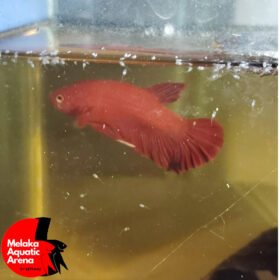Aquatic Life Care, Breeding and Reproduction, MAA Blog
Comprehensive Guide to Breeding Betta Fish: A Rewarding Experience
Comprehensive Guide to Breeding Betta Fish: A Rewarding Experience

Breeding Betta fish can be a deeply rewarding and fascinating experience. With their vibrant colors and elegant fins, Betta fish (Betta splendens) are among the most captivating freshwater fish species. However, breeding them successfully requires careful planning, meticulous preparation, and close attention to detail. This comprehensive guide will walk you through the step-by-step process of breeding Betta fish, from selecting the breeding pairs to caring for the fry.
| Outline |
|---|
| Introduction to Breeding Betta Fish |
| Understanding Betta Fish Behavior |
| Preparing for Betta Breeding |
| Setting Up a Breeding Tank |
| Essential Equipment for Breeding Betta Fish |
| Selecting the Right Breeding Pairs |
| Conditioning the Breeding Pairs |
| Tank Setup for Breeding |
| Importance of Aquatic Plants in Breeding Tanks |
| Water Treatment and Maintenance |
| Introducing the Male Betta |
| Introducing the Female Betta |
| Observing Courtship and Spawning Behavior |
| Successful Spawning and Egg Fertilization |
| Post-Spawning Care: Removing the Female |
| Caring for the Fry |
| Feeding Betta Fry |
| Maintaining Water Quality for Fry |
| Growth and Separation of Fry |
| Preventing Aggression Among Fry |
| Patience and Persistence in Betta Breeding |
| Common Challenges and Solutions in Betta Breeding |
| Tips for Successful Betta Breeding |
| Ethical Considerations in Betta Breeding |
| FAQs About Breeding Betta Fish |
| Conclusion |
Introduction to Breeding Betta Fish
Breeding Betta fish is more than just a hobby; it’s an art that combines science and patience. Enthusiasts and breeders alike find joy in watching the intricate courtship rituals and the development of vibrant, healthy fry. However, this process demands a comprehensive understanding of Betta fish behavior and needs.
Understanding Betta Fish Behavior
Betta fish, also known as Siamese fighting fish, are known for their aggressive behavior, particularly males. This aggression plays a crucial role during breeding, where the male builds a bubble nest and fiercely guards it. Understanding this behavior is essential for successful breeding, as it helps in creating the right environment and conditions for the fish.
Preparing for Betta Breeding
Before diving into the breeding process, thorough preparation is crucial. This involves setting up a dedicated breeding tank, acquiring the necessary equipment, and understanding the needs of the breeding pairs.
Setting Up a Breeding Tank
A breeding tank should be separate from the main tank to provide a controlled environment. A tank of 5 to 10 liters or more is usually sufficient. The tank should be covered to protect the bubble nest from insects, wind, and other disturbances. Reliable sources like Shopee offer affordable containers of good size for this purpose.
Essential Equipment for Breeding Betta Fish
Investing in the right equipment is essential. This includes a heater to maintain a stable temperature, an air stone for gentle aeration, and ketapang leaves for tannins. These leaves help create a natural environment that encourages breeding.
Selecting the Right Breeding Pairs
The success of breeding largely depends on selecting the right pairs. Choose healthy and vibrant Bettas with desirable traits. Complementary colors and fin types can result in stunning offspring. Avoid pairing fish with severe defects or crossing different fin types, as this can lead to undesirable traits in the fry.
Conditioning the Breeding Pairs
Conditioning involves preparing the breeding pairs with a high-quality diet and optimal environmental conditions. For two weeks before breeding, feed the fish a varied diet of live or frozen bloodworms, brine shrimp, and daphnia. Maintain a clean and warm environment, ideally between 78-80°F (25-27°C), to stimulate breeding behavior.
Tank Setup for Breeding
Creating the right environment in the breeding tank is crucial. Use ketapang leaves to provide tannins and hiding spots. Consider using a small piece of bubble wrap as a base for the bubble nest. This setup mimics their natural habitat and encourages breeding.
Importance of Aquatic Plants in Breeding Tanks
Aquatic plants like java ferns play a vital role in the breeding tank. They provide hiding spots and help establish healthy bacterial colonies. However, avoid plants like hornwort, which can complicate tank maintenance.
Water Treatment and Maintenance
Proper water treatment ensures a healthy environment for the breeding pair and the fry. Add salt, anti-chlorine, and ketapang leaves to the water. Lightly aerate the water with an air stone, but remember to remove it after 24 hours when introducing the male.
Introducing the Male Betta
Once the tank is set up and the water is treated, introduce the male Betta. Allow him to acclimate to the new environment and build his bubble nest. This nest is where he will place the fertilized eggs.
Introducing the Female Betta
Place the female in a clear container within the breeding tank. This allows the fish to see each other without direct contact, reducing aggression. Observe the male as he thickens the bubble nest and shows interest. If no nest forms, release the female after 24 hours and monitor their interaction.
@48betta4ucom ♬ Lazy Sunday – Official Sound Studio
Observing Courtship and Spawning Behavior
Watch for the male’s courtship behaviors, such as bubble nest building and flaring. The male will embrace the female under the nest, and the female will release eggs. The male fertilizes and collects the eggs, placing them in the nest.
@48betta4ucom betta fish spawning #spawnbetta #showbetta #bettafish #betta4u #showbetta2024
♬ Forest / Nature / Birds / Environmental Sound(1403230) – TrickSTAR MUSIC
Successful Spawning and Egg Fertilization
During spawning, the male Betta embraces the female, causing her to release eggs. The male then fertilizes these eggs and carefully places them in the bubble nest. This process may take several hours, and it’s crucial to monitor their interaction to ensure the female is not harmed.
Post-Spawning Care: Removing the Female
After 48 hours of spawning, remove the female from the breeding tank to prevent the male from harming her. The male will continue to guard and care for the eggs until they hatch, typically within 24-48 hours.
@48betta4ucom Conditioning your aquarium water for healthy fish and they love it. #betta4u #ketapang #betta4ubooster
♬ Relaxation music with natural sounds(1288536) – Healing Music Lab
Caring for the Fry
Once the eggs hatch, the male will care for the fry until they become free-swimming. At this stage, it’s essential to remove the male to prevent him from eating the fry. Lightly aerate the water with an air stone to prevent surface bacteria formation.
Feeding Betta Fry
Feed the fry with newly hatched baby brine shrimp, rotifer, infusoria, venegar eels or specialized fry food every 12 hours in small amounts. Avoid feeding daphnia until the fry are at least three weeks old, as they are too large for the fry to consume.
@48betta4ucom kutu air halus…. #moina #rotifer #benihikan #makananhidupikan #bundle6in1
♬ Beautiful – Soft boy
Maintaining Water Quality for Fry
Maintaining excellent water quality is crucial for the fry’s health and growth. Perform regular 50% water changes to keep the tank clean. If necessary, perform a 100% water change if the tank becomes contaminated.
Growth and Separation of Fry
As the fry grow, they may become territorial and aggressive. It’s important to separate them early into individual containers to prevent fighting and promote optimal growth. Use individual containers from sources like 1.5 litre mineral water bottles or similar capacity.
Preventing Aggression Among Fry
Preventing aggression among growing fry involves timely separation and providing ample space. This helps in reducing stress and promoting healthy development.
Patience and Persistence in Betta Breeding
Breeding Betta fish requires patience and persistence. Not all spawns will be successful, and setbacks are common. However, each experience provides valuable learning opportunities. Keep experimenting, observing, and refining your techniques.
Common Challenges and Solutions in Betta Breeding
Breeding Betta fish comes with its own set of challenges. Common issues include failed spawns, aggressive behavior, and poor fry survival rates. Address these challenges by maintaining optimal water conditions, selecting healthy breeding pairs, and providing proper care for the fry.
Tips for Successful Betta Breeding
- Maintain Clean Water: Regular water changes are crucial.
- Monitor Temperature: Keep the water temperature stable.
- Provide a Balanced Diet: Feed the breeding pairs high-quality food.
- Observe Behavior: Pay close attention to the fish’s behavior and intervene if necessary.
Ethical Considerations in Betta Breeding
Ethical breeding practices ensure the health and well-being of the Betta fish. Avoid inbreeding and prioritize the fish’s health over aesthetic traits. Responsible breeding contributes to the sustainability of Betta fish populations.
FAQs About Breeding Betta Fish
What are the ideal conditions for breeding Betta fish? Ideal conditions include a warm environment (78-80°F), clean water, and a dedicated breeding tank with hiding spots and a bubble nest.
How long does it take for Betta eggs to hatch? Betta eggs typically hatch within 24-48 hours after spawning.
What should I feed Betta fry? Feed Betta fry newly hatched baby brine shrimp or specialized fry food every 12 hours.
Why is my male Betta not building a bubble nest? Lack of a bubble nest can be due to stress, unsuitable water conditions, or the male not being ready to breed.
When should I remove the male Betta from the breeding tank? Remove the male once the fry become free-swimming to prevent him from eating them.
How can I prevent aggression among growing Betta fry? Separate the fry into individual containers as they grow to prevent territorial aggression.
Conclusion
Breeding Betta fish is a rewarding endeavor that combines passion, knowledge, and patience. By following this comprehensive guide, you can create the ideal conditions for breeding and successfully raise healthy, vibrant Betta fry. Remember, each breeding attempt is a learning experience, and persistence is key to mastering the art of Betta breeding.

Facebook | Instagram | Telegram | Youtube | Twitter | Posts | TikTok

